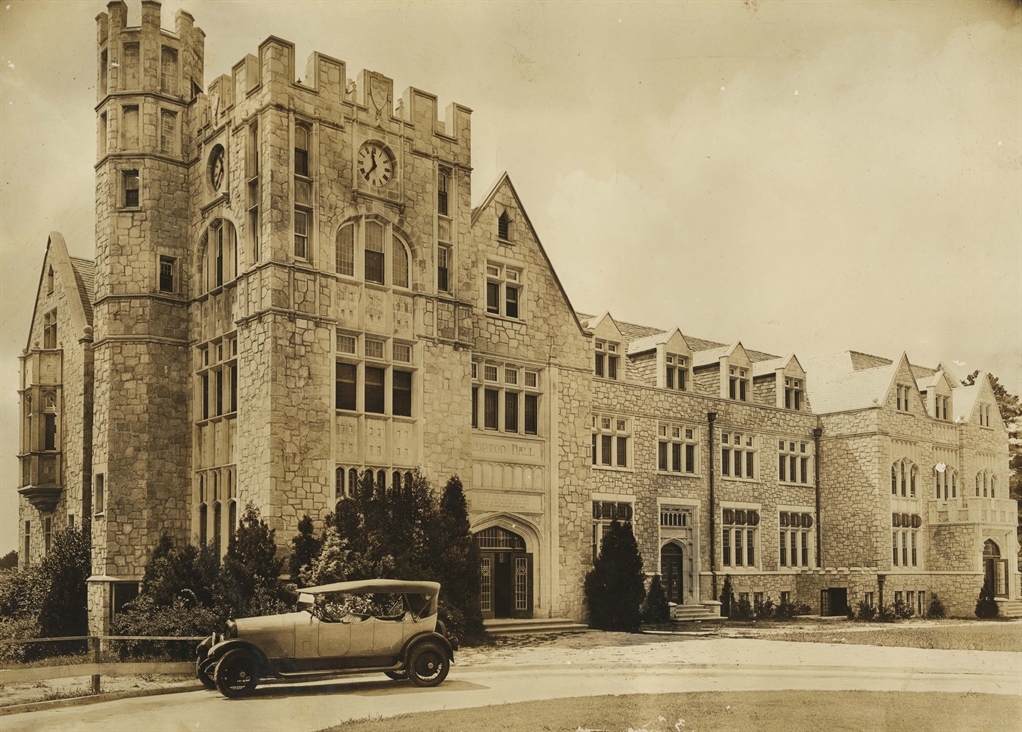History and traditions
A Brief History of Oglethorpe University
Chartered by the state of Georgia in 1835, the university commenced operations in 1838 with four faculty members and about 25 students at Midway, a small community near Milledgeville, then the capital of Georgia. Oglethorpe’s most distinguished alumnus from the antebellum era was poet, critic and musician Sidney Lanier, who graduated in 1860. The university closed in 1862 due to the Civil War when its students were soldiers, its endowment was lost in Confederate bonds and its buildings were used for barracks and hospitals. In 1870, the institution was briefly relocated in Atlanta at the site of the present City Hall. At this time, Oglethorpe produced several educational innovations, expanding its curriculum to business and law courses and offering the first evening college classes in Georgia. However, in 1872, Oglethorpe closed its doors for a second time.

Oglethorpe University was re-chartered in 1913, and in 1915 the cornerstone to the new campus was laid at its present location on Peachtree Road in Atlanta. Dr. Thornwell Jacobs, who was the driving force behind the university’s revival and who intended the new campus to be a “living memorial” to James Edward Oglethorpe, became the president for nearly three decades. During Jacobs’ tenure, he launched several projects that brought national and international repute to Oglethorpe including finding the tomb of James and Elizabeth Oglethorpe in England; conferring honorary doctorates to recognize superior civic and scientific achievement to such notables as Woodrow Wilson, Franklin Roosevelt and Amelia Earhart; and developing the Crypt of Civilization, the first modern time capsule which is located on the campus and is not to be opened until the year 8113 A.D.
In 1944, Oglethorpe University began a new era under noted attorney and educator Dr. Philip Weltner. With a group of faculty associates, Dr. Weltner initiated an exciting approach to undergraduate education called the “Oglethorpe Idea.” It involved one of the earliest efforts to develop a core curriculum, with the twin aims to “make a life and to make a living.” The Oglethorpe core, which was applauded by The New York Times, aimed at a common learning experience for students with about one-half of every student’s academic program consisting of courses in “Citizenship” and “Human Understanding.” The core curriculum remains an integral part of an Oglethorpe education today.
In recent years, Oglethorpe University has entered an era of innovation, reinvigoration, and growth, evidenced by a dramatic rise in enrollment, increased philanthropic giving, and new strategic entrepreneurial partnerships. To accommodate growth, Oglethorpe’s campus has recently seen the addition of a $16 million campus center, the expansion of our arts and athletics facilities, the addition of a residential apartment complex that includes 6,000 square feet of classrooms, and a new state-of-the-art center for science and innovation.
As Oglethorpe University continues to grow, academically and materially, it is ever mindful of its distinguished heritage and will remain, in the affectionate words of poet and alumnus Sidney Lanier, “a college of the heart.”
Oglethorpe University is listed on Georgia’s Registry of Historic Places.
Learn more about:
Detailed History
Chartered in 1835
Old Oglethorpe University began in the early 1800s with a movement by Georgia Presbyterians to establish in their state an institution for the training of ministers. For generations, southern Presbyterian families sent their sons to Princeton College in New Jersey, and the long distance traveled by stage or horseback suggested the building of a similar institution in the South. Oglethorpe University was chartered by the state of Georgia in 1835, shortly after the centennial observance of the state. The college was named after James Edward Oglethorpe, the founder of Georgia. Oglethorpe University, which commenced actual operations in 1838, was thus one of the earliest denominational institutions in the South located below the Virginia line. The antebellum college, which began with four faculty members and about 25 students, was located at Midway, a small community near Milledgeville, then the capital of Georgia.
Distinguished Alumni and Faculty
Throughout its antebellum existence, the Oglethorpe curriculum consisted primarily of courses in Greek, Latin, classical literature, theology, and a surprising variety of natural sciences. Oglethorpe’s president during much of this period was Samuel Kennedy Talmage, an eminent minister and educator. Other notable Oglethorpe faculty members were Nathaniel M. Crawford, professor of mathematics and a son of Georgia statesman William H. Crawford; Joseph LeConte, destined to earn world fame for his work in geology and optics; and James Woodrow, an uncle of Woodrow Wilson and the first professor in Georgia to hold the Ph.D. degree. Oglethorpe’s most distinguished alumnus from the antebellum era was the poet, critic, and musician Sidney Lanier, who graduated in 1860. Lanier remained as tutor in 1861 until he, with other Oglethorpe cadets, marched away to war. Shortly before his death, Lanier remarked to a friend that his greatest intellectual impulse was during his college days at Oglethorpe University.
Periods of Challenge
Old Oglethorpe in effect “died at Gettysburg.” During the Civil War its students were soldiers, its endowment was lost in Confederate bonds, and its buildings were used for barracks and hospitals. The school closed in 1862 and afterward conducted classes irregularly at the Midway location. In 1870 the institution was briefly relocated in Georgia’s postbellum capital of Atlanta, at the site of the present City Hall. Oglethorpe at this time produced several educational innovations, expanding its curriculum to business and law courses and offering the first evening college classes in Georgia. The dislocation of the Reconstruction era proved insurmountable, however, and in 1872 Oglethorpe closed its doors for a second time.
Relocation to North Atlanta
Oglethorpe University was rechartered in 1913, and in 1915 the cornerstone to the new campus was laid at its present location on Peachtree Road in Atlanta. Present to witness the occasion were members of the classes of 1860 and 1861, thus linking the old and the new Oglethorpe University. The driving force behind the university’s revival was Dr. Thornwell Jacobs, whose grandfather, Professor Ferdinand Jacobs, had served on the faculty of Old Oglethorpe.
Paying Homage to its Namesake
Thornwell Jacobs, who became the Oglethorpe president for nearly three decades, intended for the new campus to be a “living memorial” to James Oglethorpe. The distinctive Gothic revival architecture of the campus was inspired by the honorary alma mater of James Oglethorpe, Corpus Christi College, Oxford. The collegiate coat-of-arms, emblazoned with three boar’s heads and the inscription Nescit Cedere (“one who does not know how to give up”), replicated the Oglethorpe family standard. For the college athletic teams, Jacobs chose an unusual mascot – a small, persistent seabird, which according to legend, had inspired James Oglethorpe while on board ship to Georgia in 1732. The Oglethorpe University nickname “Stormy Petrels” is unique in intercollegiate athletics.
Periods of Expansion
Although Presbyterian congregations throughout the South contributed to the revival of Oglethorpe University, the school never re-established a denominational affiliation. Since the early 1920s Oglethorpe has been an independent nonsectarian co-educational higher educational institution. Its curricular emphasis continued in the liberal arts and sciences and expanded into professional programs in business administration and education. From the 1920s through the 1940s, the institution received major contributions from several individuals. Some of the most prominent benefactors were: John Thomas Lupton, Coca-Cola bottler from Chattanooga, Tennessee; Atlanta business community members Harry Hermance and Mrs. Robert J. Lowry; and publisher William Randolph Hearst. The latter gave to Oglethorpe a sizable donation of land. In the early 1930s the Oglethorpe campus covered approximately 600 acres, including 30-acre Silver Lake, which was renamed Lake Phoebe after the publisher’s mother, Phoebe Apperson Hearst.
During Thornwell Jacobs’ tenure he launched several projects which brought national and even international repute to Oglethorpe University. In 1923 Jacobs discovered the tomb of James and Elizabeth Oglethorpe in Cranham, England. For about a decade Oglethorpe University was involved in major college athletics, and the Stormy Petrels fielded football teams that defeated both Georgia Tech and the University of Georgia. Perhaps Oglethorpe’s most famous athlete was Luke Appling, enshrined in the Major League Baseball Hall of Fame. Dr. Jacobs in the 1930s became, however, one of the earliest and most articulate critics of misplaced priorities in intercollegiate athletics, and Oglethorpe curtailed development in this area. In the early 1930s Oglethorpe attracted widespread attention with its campus radio station, WJTL, named after benefactor John Thomas Lupton. Oglethorpe’s University of the Air was a notable experiment, which lasted about five years, that broadcast college credit courses on the air waves. Oglethorpe University was one of the first institutions to confer honorary doctorates on national figures in order to recognize superior civic and scientific achievement. Among Oglethorpe’s early honorary alumni were Woodrow Wilson, Walter Lippman, Franklin Roosevelt, Bernard Baruch, Amelia Earhart and David Sarnoff.
The Crypt of Civilization
Perhaps the best known of all of Jacobs’ innovations was the Oglethorpe Crypt of Civilization, which he proposed in the November 1936 issue of Scientific American. This prototype for the modern time capsule was an effort to provide, for posterity, an encyclopedic inventory of life and customs from ancient times through the middle of the 20th century. The Crypt, sealed in the foundation of Phoebe Hearst Hall in 1940, is not to be opened until 8113 A.D. It has been hailed by the Guinness Book of World Records as “the first successful attempt to bury a record for future inhabitants…”
The Oglethorpe Idea
In 1944 Oglethorpe University began a new era under Philip Weltner, a noted attorney and educator. With a group of faculty associates, Dr. Weltner initiated an exciting approach to undergraduate education called the “Oglethorpe Idea.” It involved one of the earliest efforts to develop a core curriculum, with the twin aims to “make a life and to make a living.” The Oglethorpe core, which was applauded by The New York Times, aimed at a common learning experience for students with about one-half of every student’s academic program consisting of courses in “Citizenship” and “Human Understanding.” After World War II, Oglethorpe University emphasized characteristics it had always cultivated, notably close personal relationships, in order to be, in Dr. Weltner’s words, “a small college superlatively good.” From 1965 through part of 1972 the institution was called Oglethorpe College. But the historical identity of Oglethorpe University was so strong that in 1972 the original chartered name was re-established.
Oglethorpe continued toward its goals and in the late 1960s began a facilities expansion program, which created a new part of the campus, including a modern student center and residential complex.
A Selective Liberal Arts College
By the 1980s, the Carnegie Foundation for the Advancement of Teaching had classified Oglethorpe in the category of Liberal Arts I (now referred to as Baccalaureate [Liberal Arts] Colleges I). These highly selective undergraduate institutions award more than half of their degrees in the arts and sciences. By the 1990s, the university was listed favorably in the Fiske Guide to Colleges, The Princeton Review Student Access Guide, Barron’s 300 Best Buys in College Education, National Review College Guide – America’s Top Liberal Arts Schools and many other guides to selective colleges.
Oglethorpe Today
Oglethorpe has entered an era of innovation, reinvigoration, and growth, evidenced by a dramatic rise in enrollment, increased philanthropic giving, and new strategic entrepreneurial partnerships. To accommodate growth, Oglethorpe’s campus has seen since 2013, the addition of a new $16 million campus center, the expansion of our arts and athletics facilities, the addition of a new residential apartment complex that includes 6,000 square feet of classrooms, and a new state-of-the-art center for science and innovation.

